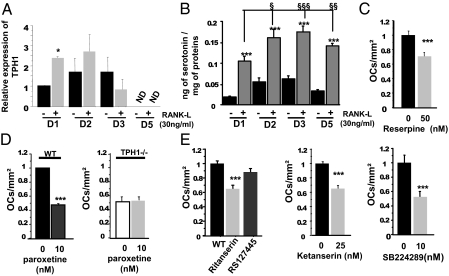Fig. 3.
Synthesis, storage, and reuptake of serotonin in WT osteoclast precursors. (A) After 4 d of treatment with M-CSF (25 ng/mL), total RNAs were isolated at different times [day (D)1, 2, 3, and 5] in the presence (gray bar) and absence (black bar) of RANKL (30 ng/mL), and RT-PCR was performed. TPH1 mRNA was expressed from day 1 to day 3. The presence of RANKL increased TPH1 mRNA expression, but only at day 1. (B) Serotonin levels were measured by HPLC in WT cell lysates. Serotonin was detected from day 1 to day 5 in the presence or absence of RANKL. An increase in serotonin level in the presence of RANKL was observed during the culture. (C) WT cells were treated with several different doses of reserpine, an inhibitor of vesicular monoamine transporter (50,100, and 200 nM), which induced a dose-dependent decrease in OCL number in WT cultures. (D) WT and TPH1−/− cultures were treated with paroxetine (10 nM), an inhibitor of SERT. Paroxetine also induced a significant decrease in OCL number in WT culture but not in TPH1−/− culture. (E) Various different substances were added to the WT culture in the presence of M-CSF and RANKL. Ritanserin (100 nM), an inverse agonist of the 5-HT2 family, induced a decrease in osteoclast number, whereas RS127445 (20 nM), a specific antagonist of 5-HT2BR, did not induce any change. Several different doses of ketanserin (25 nM), an antagonist of 5-HT2AR, were added to the WT culture. A significant dose-related decrease in osteoclast number was observed. SB224289 (10 nM) 5-HT1BR antagonist treatments of WT cells decreased the OCL number, but without any dose effect. Data are reported as mean ± SEM of four independent experiments. *P < 0.01 versus WT, **P < 0.001 versus WT, ***P < 0.0001 versus WT.

